National Science Foundation
-
- SNAME Chesapeake And MTS Washington Sections In Joint Meeting Maritime Reporter, Jan 1981 #48
A joint meeting was held in November at the Fort Meyer Officers' Club by the Chesapeake Section of The Society of Naval Architects and Marine Engineers and the Washington, D.C. Section of the Marine Technology Society.
The paper, the National Science Foundation Drilling Programs— A Status Report, by Wilbur G. Sherwood, Peter E. Wilkniss and Archie McLerran, all of the National Science Foundation (NSF), provided a subject that appealed to the similar, yet also diverse, interests of both organizations.
The presentation by Mr. Sherwood began with a brief history of the National Science Foundation's Deep Sea Drilling Program, which began in 1961 when the CUSS I drilling platform undertook nine days of drilling in 3,240 feet of water off LaJolla, Calif.
The program continued on using more capable platforms and culminated in the use of the drillship Glomar Challenger, which is now obtaining deep ocean sediment samples off the Southeast Coast of the United States.
During the past 19 years, the Deep Sea Drilling Project has added materially to our under- standing of the earth's crust, including data leading to the development of the plate tectonics model. In addition, s i g n i f i c a nt technical advances in offshore drilling, such as dynamic positioning, satellite navigation, sonar drill hole re-entry techniques, improved core bits and equipment, and improved coring techniques are now being used by the offshore oil drilling and mining industry. Other recent developments include the ability to run intermediate casings in deep water (18,000 feet or greater), successful fishing and recovery of a drill string in 18,000 feet of water, improved deepwater drill string designs, and the development of instruments capable of obtaining data from deep holes.
The limitations of the Glomar Challenger have led to the need for a more capable platform to support a major new initiative, the Ocean Margin Drilling Project, which entails drilling in 13,- 000 feet of water to depths of 20,000 feet below the subsea bottom.
This effort will be jointly funded by the U.S. Government and the oil industry, and primary emphasis will be placed on increasing basic scientific knowledge about the passive ocean margins where thick sediments exist and sophisticated well control techniques and blowout prevention are required.
It is intended to use the Government- owned Glomar Explorer for this program because of its seakeeping and stability characteristics, deadweight capacity, available volume for laboratories, and precise stationkeeping system.
To date, a baseline conceptual design has been completed and NSF intends to complete an updated Baseline Design, including trade-off studies, and to issue a request for proposals for a program systems integration contractor in Fiscal Year 1981.
-
- Webb Institute Receives Grant For Research Facilities Maritime Reporter, Oct 15, 1977 #43
Webb Institute of Naval Architecture, Glen Cove, N.Y., has announced that a grant has just been received from the National Science Foundation to provide substantial financial assistance in the construction of a hydraulically driven oscillating table. The table will provide both angular and lateral
-
- New $40 Million NSF Research Ship Fitted With Thordon Bearings Maritime Reporter, Apr 1991 #84
The R/V Nathaniel B. Palmer, owned by Edison Chouest Offshore, has been custom designed for the Antarctic research activities of the National Science Foundation. Engineered by a firm in Vancouver, and being built in Louisiana, the vessel incorporates both Thordon bearings and a water soluble
-
- U.S. Navy's AGOR 27: R/V Neil Armstrong Maritime Reporter, May 2014 #40
to today’s ceremony. The final detail design evolved over many months with frequent reviews by NAVSEA, the Office of Naval Research (ONR), the National Science Foundation (NSF) and the University National Oceanographic Laboratory System (UNOLS). On several occasions, DCI hosted review meetings attended by
-
- New Ships Join the US Research Fleet Marine Technology, Oct 2015 #14
of Hawaii. According to Schnoor, oceanographic research vessels within the U.S. ARF are owned by federal agencies (the Navy and the National Science Foundation) and state institutions, such as universities. Vessels are leased to competitively selected, oceanographic research institutions via charter
-
- Voices: Jill Zande, MATE II Marine Technology, Sep 2018 #24
that was what was missing from my education – the hands-on, applied piece.He also said that MATE was just getting started with funding from the National Science Foundation and was looking to hire people. I had always wanted to head to Monterey – who wouldn’t, with MBARI, the Aquarium, and the host of so many
-
- The Arctic: Scientists Aim to Improve Sea Ice Predictions' Accuracy, Access Marine Technology, Jan 2022 #22
a lot of public attention,” Bhatt said.Sea ice outlook forecasts began the following year and continued through 2013 on minimal funding. The National Science Foundation began providing financial support in 2014, allowing the eventual inclusion of forecasts for Alaska and Antarctica.The network uses dozens
-
- ITT Antarctic Seeks Bids For Charter/Purchase Of Icebreaker For NSF Maritime Reporter, Feb 1989 #26
ITT Antarctic Services, Inc., under contract to the National Science Foundation, Division of Polar Programs, is seeking the charter/purchase of an icebreaking research vessel to operate in the Antarctic and southern ocean waters in support of the U.S. Antarctic Program. The general purpose, multidisci
-
- Ship Model Basin Dedicated At N.Y. State Maritime College Maritime Reporter, Jan 15, 1983 #20
with nonstate funds, mainly from the Alumni Association college support drive, from the Maritime College at Fort Schuyler Foundation, and from the National Science Foundation
-
- Sailing for Science Marine Technology, Jul 2013 #52
Oceanographic Fleet to get a sense of where the fleet is today, and what the future holds. His report summarizes his conversations with the National Science Foundation (NSF); Office of Naval Research (ONR); National Oceanic and Atmospheric Administration (NOAA); and University of California-San Diego’s
-
- The US Government Must Fund Icebreakers Now Maritime Reporter, Mar 2018 #12
Requirements Study, prepared jointly by the Coast Guard, Department of Transportation, Maritime Administration, Department of Defense, National Science Foundation, National Oceanic and Atmospheric Administration and Office of Management and Budget, recommended that four polar icebreakers would be required
-
- Vigor Adds $20 Mln Drydock Maritime Reporter, Jan 2018 #42
research vessel operated by the University of Washington. The $45 million project was funded by the U.S. Navy’s Office of Naval Research and the National Science Foundation and included a complete overhaul of the propulsion, navigation and core engineering systems as well as improvements to lab space and science
-
 )
March 2024 - Marine Technology Reporter page: 41
)
March 2024 - Marine Technology Reporter page: 41Image courtesy Outland Technology Image courtesy Exail Image courtesy Submaris and EvoLogics Vehicles The ROV-1500 from Outland Technology represents a leap forward in underwater robotics, a compact remotely operated vehicle (ROV) weighing in at less than 40 lbs (19kg) the ROV- 1500 is easy to transport
-
 )
March 2024 - Marine Technology Reporter page: 37
)
March 2024 - Marine Technology Reporter page: 37miscible barrier ? uid heavier than seawater (sg=1.026) and lighter than the battery electrolyte (sg=1.265). The original cell vent cap was screwed into the top of the riser pipe to vent the gases associated with charging. Wires were soldered to the lead (Pb) posts. The lead-acid battery was additionall
-
 )
March 2024 - Marine Technology Reporter page: 25
)
March 2024 - Marine Technology Reporter page: 25shore Wind Turbine Phase two, mapping inside the caldera, • Geotechnical InvesO gaO on • Sand Resource InvesO gaO on featured SEA-KIT International’s USV Maxlimer and marked the ? rst time an uncrewed surface vessel had been used to survey the aftermath of subsea volca- nic activity. Controlled
-
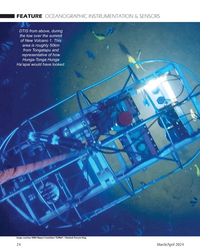 )
March 2024 - Marine Technology Reporter page: 24
)
March 2024 - Marine Technology Reporter page: 24FEATURE OCEANOGRAPHIC INSTRUMENTATION & SENSORS DTIS from above, during the tow over the summit of New Volcano 1. This area is roughly 50km from Tongatapu and representative of how Hunga-Tonga Hunga Ha’apai would have looked. Image courtesy NIWA-Nippon Foundation TESMaP / Rebekah Parsons-King 24
-
 )
March 2024 - Marine Technology Reporter page: 23
)
March 2024 - Marine Technology Reporter page: 23. Submarine volcanoes are largely unknown, in contrast with their sub-aerial (above-ground) counterparts. Kevin Mackay, marine ge- ologist at the National Institute of Water and Atmosphere Research (NIWA), New Zealand, said, “There are over one million underwater volcanoes, although only about 120
-
 )
March 2024 - Marine Technology Reporter page: 22
)
March 2024 - Marine Technology Reporter page: 22FEATURE OCEANOGRAPHIC INSTRUMENTATION & SENSORS Aerial view of HT-HH volcano, showing new multibeam depth data overlaid on islands satellite image. © SEA-KIT, NIWA-Nippon Foundation TESMaP 22 March/April 2024 MTR #3 (18-33).indd 22 4/4/2024 9:08:10 AM
-
 )
March 2024 - Marine Technology Reporter page: 15
)
March 2024 - Marine Technology Reporter page: 15interview on the Slocum Sentinel Glider with Shea Quinn will continue to grow – and the Sentinel is big enough to and Clayton Jones from Oceanology International 2024 in London. take on the challenge. Welcome to the World of ROS Positioners The Most Complete Line of Reliable and Accurate Positioners in the
-
 )
March 2024 - Marine Technology Reporter page: 8
)
March 2024 - Marine Technology Reporter page: 8in the northwestern Black They now pose a hazard to all maritime traf? c, regardless of Sea, which would not only have ceded control of Odessa, but national origin, prompting Turkey, Bulgaria, and Romania to enabled Russia to open up a second front. By all indications form a joint mine countermeasures
-
 )
March 2024 - Marine Technology Reporter page: 6
)
March 2024 - Marine Technology Reporter page: 6received Undersecretary and Assistant an honorary Doctor of Sci- Secretary of Commerce, acting and Deputy Administrator of the ence degree from Shang- National Oceanic and Atmospheric Administration (NOAA), and hai Ocean University in 2018. He proposed making thick wall Oceanographer of the Navy. He has
-
 )
March 2024 - Marine Technology Reporter page: 4
)
March 2024 - Marine Technology Reporter page: 4Editorial NIWA-Nippon Foundation TESMaP/ Rebekah Parsons-King www.marinetechnologynews.com ast month marked the resounding NEW YORK 118 E. 25th St., New York, NY 10010 return of Oceanology Interna- Tel: (212) 477-6700; Fax: (212) 254-6271 tional in London, perennially one Lof the world’s most important
-
 )
March 2024 - Marine Technology Reporter page: 2
)
March 2024 - Marine Technology Reporter page: 2‘24 ‘That’s a Wrap’ From new product debuts -- cables and connectors, vehicles, sub bottom pro? lers 40 -- to many deals done, Oceanology International 2024 was a great success. 4 Editor’s Note 6 Authors & Contributors 6 Editorial Board 16 Tech Feature: IMR 47 Classi? eds 48 Advertisers Index MTR
-
 )
April 2024 - Maritime Reporter and Engineering News page: 38
)
April 2024 - Maritime Reporter and Engineering News page: 38, Guatemala and El Salvador. Each ship will feature 300 Image courtesy HRDD refrigerated unit plugs. The four Avance-class ships are named after national birds, archaeological sites and lakes in Central lassNK granted its “SCCS-Full” class notation to America, Crowley said on social media. The newbuilds
-
 )
April 2024 - Maritime Reporter and Engineering News page: 35
)
April 2024 - Maritime Reporter and Engineering News page: 35SIMULATION e have a close relationship with tech- Realism is prized beyond immersive, photo-realistic visu- nology, evidenced by, for example, als, and providers are introducing increasingly accurate func- the phones we are estimated to un- tionality. FORCE Technology’s upcoming DEN-Mark2 math- lock around
-
 )
April 2024 - Maritime Reporter and Engineering News page: 32
)
April 2024 - Maritime Reporter and Engineering News page: 32FEATURE A closeup of a blade installation process taken via drone. A blade handling system is apparent (in yellow). Images courtesy of Mammoet requirement for the development of these cranes, particularly ling area. This would result in a major time and fuel saving. in ? oating offshore wind,” says
-
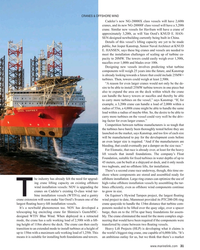 )
April 2024 - Maritime Reporter and Engineering News page: 31
)
April 2024 - Maritime Reporter and Engineering News page: 31CRANES & OFFSHORE WIND Cadeler’s new NG-20000X class vessels will have 2,600t cranes, and its new NG-20000F class vessel will have a 3,200t crane. Similar new vessels for Havfram will have a crane of approximately 3,200t, as will Van Oord’s KNUD E. HAN- SEN-designed newbuilding currently being built in
-
 )
April 2024 - Maritime Reporter and Engineering News page: 27
)
April 2024 - Maritime Reporter and Engineering News page: 27worked We are in that tough period with both recruiting and reten- their way up the “hawsepipe” from able bodied seaman to tion at the same time. It’s a national problem. master on our ships. We really want to grow our mariners We need to ensure our pay and bene? ts; the predictability from within. There’s
-
 )
April 2024 - Maritime Reporter and Engineering News page: 14
)
April 2024 - Maritime Reporter and Engineering News page: 14Book Review Approach to Meeting Underwater Radiated Noise Limits Def ned By Raymond Fischer uantitative underwater radiated noise limits will construction inspections, 5) possible training with respect to be developed shortly by IMO, and/or countries salient design/construction essentials, 6) compliance
-
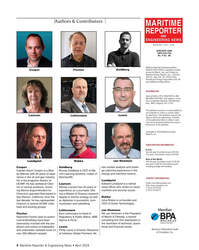 )
April 2024 - Maritime Reporter and Engineering News page: 4
)
April 2024 - Maritime Reporter and Engineering News page: 4Authors & Contributors MARITIME REPORTER AND ENGINEERING NEWS M A R I N E L I N K . C O M ISSN-0025-3448 USPS-016-750 No. 4 Vol. 86 Maritime Reporter/Engineering News (ISSN # 0025-3448) is published monthly Cooper Fischer Goldberg except for March, July, and October by Maritime Activity Reports, Inc.
-
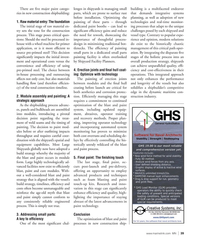 )
April 2024 - Marine News page: 39
)
April 2024 - Marine News page: 39There are ? ve major paint catego- lenges in shipyards is managing small building is a multifaceted endeavor ries in new construction shipbuilding: parts, which are prone to surface rust that demands integrative systems before installation. Optimizing the planning, as well as adoption of new 1.
-
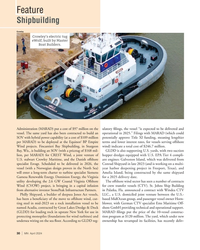 )
April 2024 - Marine News page: 30
)
April 2024 - Marine News page: 30Feature Shipbuilding Crowley Crowley’s electric tug eWolf, built by Master Boat Builders. Administration (MARAD) put a cost of $97 million on the ulatory ? lings, the vessel “is expected to be delivered and vessel. The same yard has also been contracted to build an operational in 2025.” Filings with
-
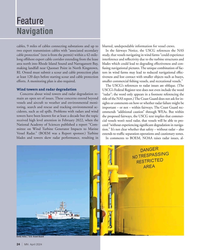 )
April 2024 - Marine News page: 24
)
April 2024 - Marine News page: 24USCG text implies that commer- received high level attention in February 2022, when the cial vessels won’t need radar, that vessels will be able to pro- National Academy of Sciences published a report “Com- ceed “without experiencing signi? cant degradation in naviga- mittee on Wind Turbine Generator Impacts
-
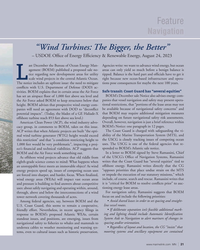 )
April 2024 - Marine News page: 21
)
April 2024 - Marine News page: 21Feature Navigation “Wind Turbines: The Bigger, the Better” – USDOE Of? ce of Energy Ef? ciency & Renewable Energy, August 24, 2023 ast December the Bureau of Ocean Energy Man- Agencies write: we want to advance wind energy, but ocean agement (BOEM) published a proposed sale no- areas can only yield so
-
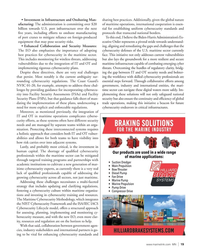 )
April 2024 - Marine News page: 19
)
April 2024 - Marine News page: 19Man- sharing best practices. Additionally, given the global nature ufacturing: The administration is committing over $20 of maritime operations, international cooperation is essen- billion towards U.S. port infrastructure over the next tial for establishing uniform cybersecurity standards and ? ve years
-
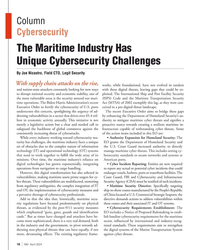 )
April 2024 - Marine News page: 18
)
April 2024 - Marine News page: 18not evolved in tandem and nation-state attackers constantly looking for new ways with these digital threats, leaving gaps that could be ex- to disrupt national security and economic stability, one of ploited. The International Ship and Port Facility Security the most vulnerable areas is the security around
